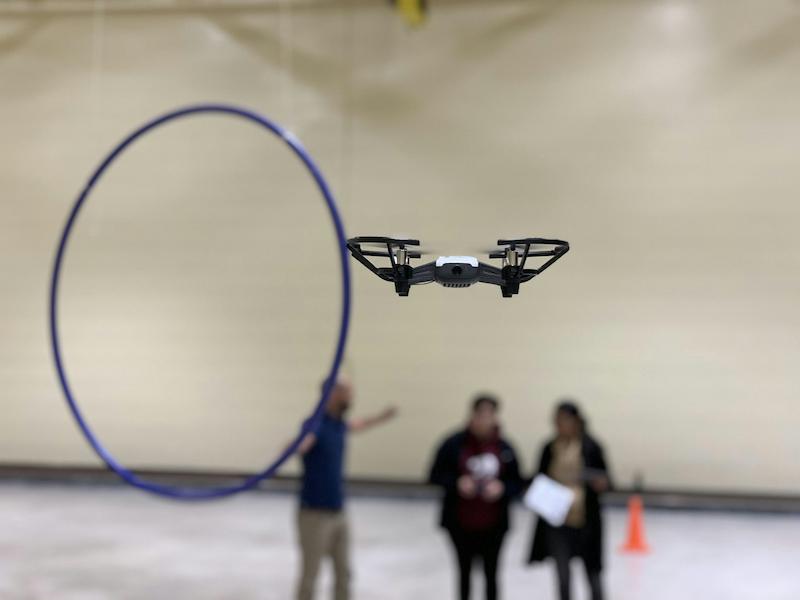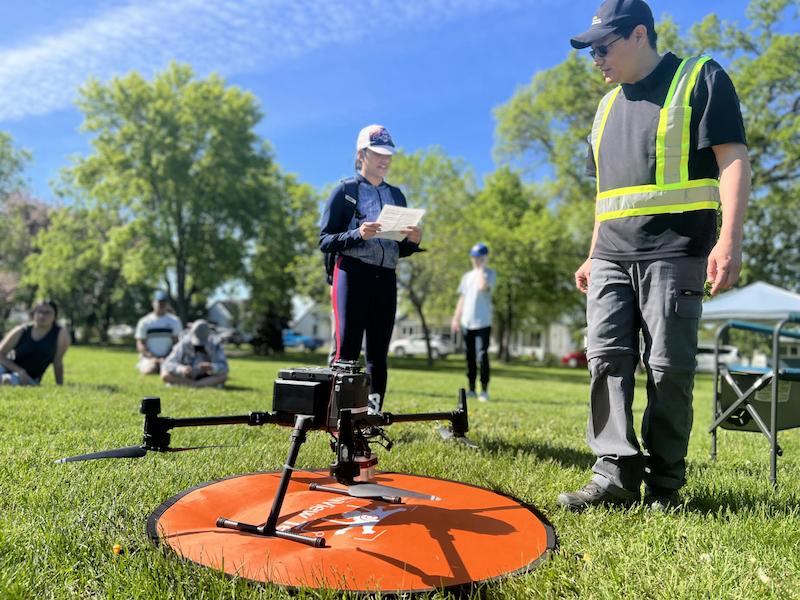As drones become more commonly integrated into society, the demand for skilled professionals who can leverage the potential of this technology across a wide range of use cases continues to rise. Recognizing the need to cultivate a new generation of drone experts, Volatus Aerospace created the Science Experiential Aerial Research (SEAR) program to bolster drone education and grow the workforce the industry needs today…and into the future.
The Genesis of SEAR: A Teacher’s Vision
The SEAR program’s origin story is as compelling as its mission. Matt Johnson, Volatus’ Vice President and Director of Education, a former high school math teacher with a passion for aviation and a knack for identifying real-world applications for burgeoning technologies, visioneered the SEAR initiative.
Johnson’s journey into the drone industry began, in his words, as a “side hustle” in 2015 when he sought to explore the potential opportunities within this new field. It didn’t take long for him to realize the vast potential drones held. This led him to specialize in agriculture and to simultaneously develop a drone pilot training program.
Johnson’s experience in education and aviation converged when he recognized the potential of drones as educational tools. Johnson’s vision introduced students to drone technology but also engaged them in real-world research and problem-solving. “The approach that I’ve taken to using drones as an educational tool is less focused on using them to teach about the drones themselves, but rather to teach other curricular outcomes,” he explained.
He conceived the SEAR program in 2021 and launched it the following year. The initial pilot project partnered with a Winnipeg-based School division and 15 students. Within that first year, the program received a $500,000 grant from the Provincial Government of Manitoba to help cover registration costs. Shortly after, Volatus partnered on a research study with the University of Winnipeg that would fully immerse the SEAR program students in the real-world scientific research from that study. The program has been soaring since then, from San Diego, Texas all the way to Taloyoak, Nunavut.
Drones as Tools, Not Toys: Shifting the Focus to Science
A key aspect of the SEAR program is its emphasis on drones as tools for scientific exploration and problem-solving, rather than mere recreational devices. Johnson stresses that the program is “a science program first and foremost,” in which drones serve as a medium for teaching scientific concepts.
“I’m teaching science; I’m teaching about the electromagnetic spectrum; I’m talking about photosynthesis and using different concepts from science, physics, chemistry and biology, as well as geography and visual arts. while incorporating drones as the medium to teach about those things,” Johnson explained.
By shifting the focus from the drone itself to the underlying scientific principles, the SEAR program broadens students’ perspectives and equips them with a deeper understanding of the world around them. This approach also helps to dispel misconceptions about drones and highlights their potential for beneficial applications in various fields.

Experiential Learning: A Cornerstone of SEAR
At the heart of the SEAR program is a commitment to experiential learning, an approach that emphasizes hands-on activities, real-world problem-solving and active engagement. Drawing upon his background in education, Johnson recognizes the power of experiential learning to ignite students’ curiosity and foster a deeper understanding of complex concepts.
Reflecting on his own educational experiences, Johnson noted, “That kind of experiential learning is something I can still remember to this day.” He continued, “Those palpable experiences for students that bring concepts to life are so incredibly valuable.”
The SEAR program provides students with opportunities to apply their knowledge in practical settings, whether it’s collecting aerial research data using drones, processing data to create high-resolution 3D models or developing machine learning algorithms to analyze the data they collect. This hands-on approach not only reinforces theoretical concepts but also cultivates critical thinking, problem-solving and teamwork skills.
SEAR Projects: Real-World Research for Students
Johnson structured the SEAR program around three core projects that he purposefully designed to address relevant community sustainability issues while providing students with hands-on experience in data collection, analysis and problem-solving:
Dutch Elm Disease Detection
This project focuses on identifying American elm trees within urban canopies that are infected with Dutch elm disease. By utilizing drones equipped with specialized multispectral remote sensors, students can detect the disease before it becomes visually apparent. This enables municipal crews to treat the trees and prevent further spread. The program can be customized to other tree species and pathogens based on regional relevance.
Agricultural Crop Disease Identification
Similar to the Dutch elm disease project, this initiative seeks to identify crop species, growth stages and potential diseases across various agricultural crops such as wheat, canola, and corn. Students learn about high-tech drone applications in agricultural settings as well as basic agronomy skills, the science of growing crops. This helps them gain valuable insights into precision agriculture and sustainable farming practices.
Coastal and Community Litter Mapping
This project aims to identify the presence of litter and garbage debris on coastal beaches, lake and river shorelines, or urban spaces such as parks. Students use drones to collect data and employ machine learning tools to analyze and categorize litter based on the way they interact with various wavelengths of the electromagnetic spectrum. This initiative contributes to efforts to combat pollution and promote environmental stewardship.
These three projects reflect the primary community regions (rural/remote, urban, coastal) where the program can be offered. In each project, students learn how to collect data and then use machine learning tools to analyze it. Through this method, Johnson fully engages SEAR students in the scientific discovery process.
Machine Learning: Unlocking the Power of Data
Given the prevalence of data-driven decision-making across a range of disciplines and industries, the ability to analyze and interpret vast amounts of information has become a critical skill. The SEAR program recognizes the importance of machine learning in unlocking the power of data and so provides students with hands-on experience in developing and applying machine learning algorithms.
“Machine learning plays a critical role in all of this,” Johnson emphasizes. “We collect the data, and then we use machine learning tools to analyze it automatically.”
For example, in the Dutch elm disease project, students use machine learning algorithms to analyze aerial images of urban canopies, identifying elm trees and assessing their health based on reflectance values. This process involves training the algorithms to recognize patterns and anomalies in the data to accurately detect diseases and other issues with a high degree of certainty.

Overcoming Obstacles and Seizing Opportunities
While the SEAR program has achieved remarkable success, it has also faced its share of challenges. One of the primary obstacles is the cost of drone equipment and programming, which can be prohibitive for many schools and educational institutions. To address this issue, Volatus Aerospace has actively sought grants and funding opportunities to help offset the costs of equipment and training.
“There are lots of grants out there,” Johnson advised. “First of all, just try to find funding bodies.”
Another challenge is the need to adapt the program to different learning environments and student populations. The SEAR program has been implemented in a variety of settings, from urban high schools to rural and extremely remote communities and colleges. This requires constant flexibility and creativity on the part of instructors and administrators.
Despite these challenges, the SEAR program continues to thrive, thanks to the dedication of its staff, the support of its partners, and the enthusiasm of its students. As the drone industry continues to evolve, the SEAR program will undoubtedly play an increasingly important role in shaping its future.
A Vision for the Future of Drone Education
Looking ahead, Volatus Aerospace envisions expanding the SEAR program to reach even more students and communities across North America and beyond. The company is actively exploring partnerships with universities, government agencies and industry stakeholders to create new opportunities for drone education and workforce development.
“We can customize programming,” Johnson explained. “We can see what kind of ecological sustainability problems might be present in their area and how we can use our equipment and our expertise to help them with a research to go after that and then tie in the schools around them to pitch in for a solution.”
Volatus Aerospace is also committed to developing new and innovative educational resources, including online courses, virtual reality simulations and augmented reality applications. By leveraging the power of technology, the company aims to make drone education more accessible, engaging and effective for learners of all ages and backgrounds.
Inspiring the Next Generation of Drone Professionals
Ultimately, the goal of the SEAR program is to empower the next generation of drone professionals. By providing students with first-hand real-world research opportunities and exposure to cutting-edge technologies, the program aims to cultivate a pipeline of skilled and knowledgeable individuals who can drive innovation and shape the future of the drone industry.
“It’s really cool when the students are inspired through the programs that we run,” Johnson noted. “The coolest thing about being a teacher is when you can get a student to get enthusiastic about something and push themselves to do something that’s difficult.”
The SEAR program has already had a significant impact on students’ lives. Many participants have gone on to pursue advanced drone certifications and careers in the drone industry. By instilling a passion for learning and a commitment to excellence, the SEAR program helps to create a workforce that is well-equipped to meet the challenges and opportunities of society, now and into the future.
Volatus Aerospace’s SEAR program stands out as a shining example of how education can be a catalyst for innovation and workforce development. By providing students with hands-on experience, real-world research opportunities and exposure to cutting-edge technologies, the program is inspiring a new generation of drone experts who will be well-equipped to shape the future of this exciting field.To learn more about the SEAR program and Volatus Aerospace’s other educational initiatives, visit Drones in Ed.
